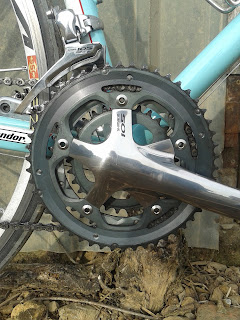Over half a year and
several thousand kilometres since I bought it, the Acciaio frame-set is still here.
That's not something to take for granted: the turnover in the shed can be
brutal. More than that, though, it's still built up. And more than that,
it's the bike I ride more than any other. So, what else to add to my early-days
review?
I played with the setup
more or less continuously until about a month ago. The basics have stayed the
same: frame plus standard Condor full-carbon fork, Easton seatpost, Ritchey
110mm stem, Deda RHM02 bars, and mainly Ultegra groupset. The fiddling has been
with the gearing: I started with a compact, switched to a (105) triple,
switched back to the compact but with a 38-tooth inner ring, then switched back
to the triple.
The conclusion? I remain a fan of triples, and an out-and-out
heckler of compacts. For me, the jump down from 50 to 34 on a compact is just
too big. You shift the front derailleur, then have to crash down multiple gears
at the back to get anything like a similar cadence. On a triple, especially a 110PCD triple (50-39-30), one change down at the front and one at the
back is just about perfect.
The 30-tooth inner ring is
little used, hence the experiment with a 50-38. I would have stuck with that,
but the TA 38-tooth ring refused to shift smoothly, getting hung up on the downshift
from the 50. So, back to the triple and its extra 100g or so.
Contact points
I've tried various
saddles, ending up with a Fizik Aliante. Fizik say this saddle is good for
people who lack flexibility, but I'm actually quite flexible (at least by their
simplistic can-you-touch-your-toes measure). The reason I prefer it is that
when you want to extend your legs for a bit more power, you can slide back on
to the rear of the saddle for a slightly higher, longer seating position.
I've also played about with the bars a bit. After a brief flirtation with some old Big Piegas, I've been using Deda's RHM02 bars. The jury's a bit out on these: the drop and curve are very comfortable, the forward bend (in the photo on the right) less so. A shallower radius would be more comfortable; this bend is so square it forces my hands further out than I'd like, making the bars feel wider than others of a similar size. On balance, I find the old FSA compacts, which were slightly narrower at the top than the drops, preferable.
Wheels
Wheels can make or break
a bike. I've used the lightweight Ksyrium SLs shown in the photo on the
Acciaio, and also some nice-but-sturdy Harry Rowland 32-spoke wheels on
Ambrosio hubs and Open Pro rims. The difference is marked, as you'd expect.
With the SLs, the bike responds very readily to a press on the pedals, and
accelerates quickly. The Rowlands give the bike a different character – not
necessarily less enjoyable. It feels like a machine you can happily
ride on cobbles and dirt roads, a real bruiser. Still, though, lightweight
enough for fast riding.
Weight
We had to come to this in
the end, didn't we? Depending on what bits it's wearing, the Acciaio (a size 55 frame) comes
up at a bit under or a bit over 9kg: pretty heavy, relatively, for a bike that
would cost about £2000 to build up to this spec from scratch (though about the
same as a £1500 Specialized Roubaix). So, you could easily get something
lighter for less. It just might not be as satisfying to ride or own.
Summary
It's possible to disguise
a good frame using poor kit (especially wheels). It's also possible to make
a so-so frame ride better with expensive equipment (especially wheels). I've built up
and ridden the Acciaio frame with a range of middling and (in the case of the
wheels) a-bit-better-than-middling kit, which has given me a good feel for its
capabilities. I'd summarise it as a thoroughly modern version of an old-school
steel frame. It's stiff enough to transfer power from your legs
efficiently, is still comfortable on long rides (probably the most comfortable road
bike I've owned), and is engaging to ride. (I'm trying really hard not to say
"lively" here...)
Most of all, the Acciaio has a versatile nature that's welcome in an age of niches within niches.
Build it light, drop the stem, and it feels close to a flat-stick race bike. Use more robust
components, and you've got yourself a cobble basher. Strike the middle ground,
and you have something that can do everything.
And it looks
pretty, too.

















